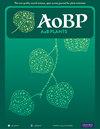Adaptive constraints at the range edge of a widespread and expanding invasive plant
IF 2.6
3区 生物学
Q2 ECOLOGY
引用次数: 0
Abstract
Abstract Identifying the factors that facilitate and limit invasive species range expansion has both practical and theoretical importance, especially at the range edges. Here, we used reciprocal common garden experiments spanning the North/South and East/West range North American core, intermediate, and range edges of the globally invasive plant, Johnsongrass (Sorghum halepense) to investigate the interplay of climate, biotic interactions (i.e., competition), and patterns of adaptation. Our results suggest that rapid range expansion of Johnsongrass into diverse environments across wide geographies occurred largely without local adaptation, but that further range expansion may be restricted by a fitness trade-off which limits population growth at the range edge. Interestingly, plant competition strongly dampened Johnsongrass growth but did not change the rank order performance of populations within a garden, though this varied among gardens (climates). Our findings highlight the importance of including the range edge when studying the range dynamics of invasive species, especially as we try to understand how invasive species will respond to accelerating global changes.一种广布扩张的入侵植物范围边缘的适应性约束
识别促进和限制入侵物种范围扩张的因素具有重要的现实意义和理论意义,特别是在范围边缘。在这里,我们使用互惠的共同花园实验,跨越北/南和东/西范围北美核心,中间和范围边缘的全球入侵植物,强Johnsongrass(高粱),调查气候,生物相互作用(即竞争)和适应模式的相互作用。我们的研究结果表明,约翰逊草在广泛地理区域的多样化环境中的快速范围扩张在很大程度上是在没有局部适应的情况下发生的,但进一步的范围扩张可能受到适应性权衡的限制,这限制了范围边缘的种群增长。有趣的是,植物竞争强烈地抑制了约翰逊草的生长,但没有改变花园内种群的等级顺序表现,尽管这在不同的花园(气候)中有所不同。我们的研究结果强调了在研究入侵物种的范围动态时包括范围边缘的重要性,特别是当我们试图了解入侵物种如何应对加速的全球变化时。
本文章由计算机程序翻译,如有差异,请以英文原文为准。
求助全文
约1分钟内获得全文
求助全文
来源期刊

AoB Plants
PLANT SCIENCES-
CiteScore
4.80
自引率
0.00%
发文量
54
审稿时长
20 weeks
期刊介绍:
AoB PLANTS is an open-access, online journal that has been publishing peer-reviewed articles since 2010, with an emphasis on all aspects of environmental and evolutionary plant biology. Published by Oxford University Press, this journal is dedicated to rapid publication of research articles, reviews, commentaries and short communications. The taxonomic scope of the journal spans the full gamut of vascular and non-vascular plants, as well as other taxa that impact these organisms. AoB PLANTS provides a fast-track pathway for publishing high-quality research in an open-access environment, where papers are available online to anyone, anywhere free of charge.
 求助内容:
求助内容: 应助结果提醒方式:
应助结果提醒方式:


